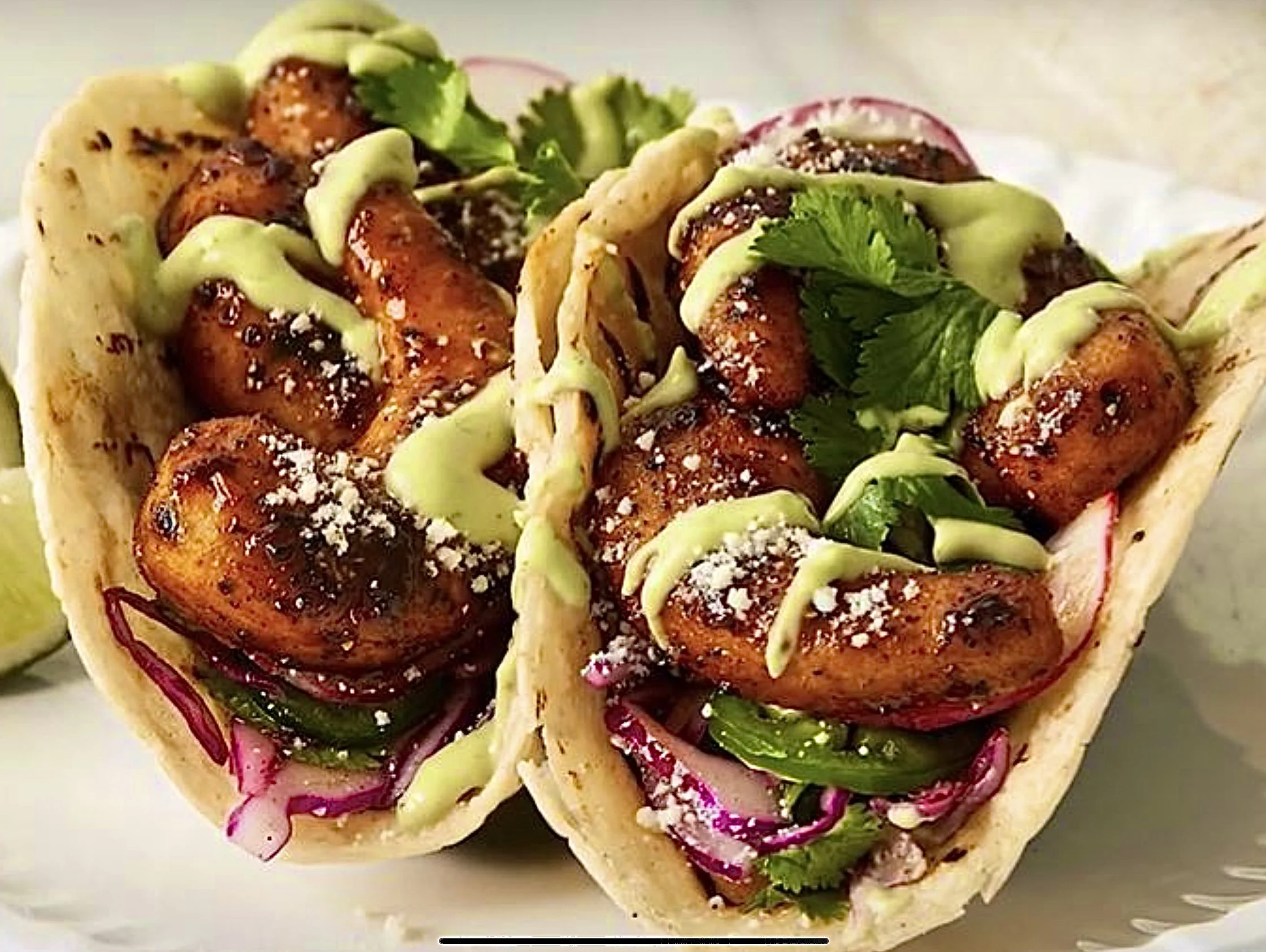Photo: Cajun style, plant-based shrimp from New Wave Foods
By Jessica Scott-Reid
Jessica is a Canadian writer, animal advocate and plant-based food expert. Her work appears regularly in media across Canada and the US.
For conscious consumers looking to cut down on the eco-impact of their food choices, some think opting to eat animals farmed in water rather than on land may be a good idea. Research has identified aquafarming as less environmentally harmful compared to farming most land animals. However, farming animals in water, also known as aquaculture, can hardly be described as harm-free.
Shrimp farming, for example, which has increased in recent years due to growing demand for low-fat shellfish, comes with a variety of environmental and human health concerns. Now, health and environmental advocates are sounding the alarm on this multibillion-dollar industry, as well as pointing to a booming shrimp alternatives market offering better options for people and the planet.
Aquaculture/farmed shrimp in India. India is the largest exporter of shrimp to the US. Photo: S. Chakrabarti, We Animals Media
Today, over half of the world’s shrimp consumed by humans is farmed. “Shrimp aquaculture has grown dramatically over the past 20 years,” explains Tessa Gonzales with the Aquatic Life Institute, “now producing 350 billion shrimp per year.” And the majority, she adds, are farmed in earthen bodies of water—manmade ponds or large pools, rather than in the ocean—in Asian countries.
Aerating turbines on an Indian shrimp aquafarm. Photo: S. Chakrabarti, We Animals Media
Though farmed outside of the ocean, shrimp aquaculture still has a notable impact on the environment. For example, explains Philippa Thornton, Senior ESG analyst at Farm Animal Investment Risk and Return Initiative (FAIRR), the industry is one of the leading causes of deforestation in Southeast Asia. “Mangrove forests are cleared to make way for new shrimp production sites, damaging local ecosystems and a natural storm barrier,” she says, noting 30-50% of mangrove forests have been cleared for shrimp production. “This is the main carbon-intensity driver for shrimp—which is more carbon intensive than poultry,” she adds.
A 2020 study published in the journal Nature, also found that farmed shrimp, prawns and finfish generate more GHGs kilo for kilo than bivalves, stating that “shrimp and prawns are high emitters because of the energy required for water aeration and pumping.” This is because shrimp are farmed at high stocking densities that require very energy intensive biosecurity measures.
Shrimp being cleaned in a processing plant in Andhra Pradesh, India. Photo: S. Chakrabarti, We Animals Media
And, due to these high stocking densities, antibiotic use has also been flagged as a major concern regarding shrimp production and consumption. “Using antibiotics is common practice for shrimp farmers. They are used to combat the prevalence of disease on farms,” Thornton explains. “High levels of antibiotic use in shrimp farms contribute to the development and spread of antimicrobial resistance (AMR).”
AMR, according to the World Health Organization, is one of the top 10 global public health threats facing humanity. But it is not only a concern for those consuming shrimp. “Shrimp farms are mostly uncontained and lack effective waste management treatment and control,” Thornton adds. “This means that effluent from shrimp farms goes directly into the surrounding areas, including antibiotic residues. Studies have shown multi-drug resistance around shrimp farms and in surrounding areas.”
Plant-based shrimp dishes from (l to r): New Wave Foods and The Plant Based Seafood Co.
Due to these growing concerns, as well as thanks to an increasing appetite for meat alternatives in general, the shrimp alternatives market has been growing over the last few years. “There are plenty of new product releases and continued innovation happening in the plant-based shrimp space,” notes plant-based business expert and founder of VEGPRENEUR, Noah Hyams. “In 2021, start-up New Wave Foods completed an $18 million Series A round of financing to take on the $9 billion shrimp market with plant-based shrimp made of sustainable seaweed and other plant proteins,” he says. “And Ukrainian company Green Go, launched in 2021, creates realistic plant-based shrimp and calamari.”
There are also brands such as Sophie’s Kitchen, which makes a plant-based breaded shrimp, Plant Based Seafood Co., which sells a coconut crusted shrimp-less shrimp, and Happy Veggie World, which makes a super similar un-breaded, soy-based shrimp.
Shiok Meats is one of the new cell-cultured meat companies shaking up the seafood industry.
Cell-cultured shrimp is also in the works, Hyams notes, with start-ups including Shiok Meats and CellMEAT recently receiving promising funding to scale up production.
Finally, re-creating a healthy, delicious and lower impact shrimp-like experience in your own kitchen is also doable. Recipes using mushrooms, such as king oyster and lion’s mane, can transform the meaty fungi into shrimp-like delights. And a special Asian root vegetable called Konjac, also known as the base for “skinny noodles” closely mimics the texture of shrimp and is used in recipes for shrimp alternatives.
Though shrimp farming may produce a lesser eco-footprint than other forms of factory animal farming, there is still much for the conscious consumer to be concerned about. Plant-based and other animal-free shrimp alternatives offer healthful and eco-friendly options, ready to be enjoyed with all the lemon and garlic that shrimp fans love.







